2020 NBA Re-Draft: Tyrese Haliburton vs. Anthony Edwards vs. LaMelo Ball, Who Ya Got?
Andy Bailey@@AndrewDBailey2020 NBA Re-Draft: Tyrese Haliburton vs. Anthony Edwards vs. LaMelo Ball, Who Ya Got?

Every NBA draft is met with instant analysis, grades and other reactions, but much of it ignores a pretty important fact: None of us really knows who'll be good and who won't in the moment.
Even three years later, definitives about the 2020 class are probably premature, but we now have a pretty robust sample to draw from.
With the benefit of years of evidence, we can re-draft with more confidence in all of the players below than we had in 2020.
Placements can also be affected by changing philosophies about the game. Skill at all five positions is more important than it's ever been. Size at guard and wing spots can be a huge advantage. Shooting remains vital.
With all of that, numbers and plenty of time spent watching the players from this group, this is how the lottery should play out now, if we assume the entire class is available and we're dealing with 14 generic teams (rather than the order from 2020).
Outside the Lottery
- No. 2 pick James Wiseman is finally showing some signs of progress with the Detroit Pistons, but there's still a long way to go for him to be impactful on either end. For his career, his teams are minus-14.2 points per 100 possessions when he's on the floor and minus-1.1 when he isn't.
- Isaac Okoro has shown flashes of three-and-D upside. He's hit 39.5 percent of his attempts from deep this season. But his presence is just felt far less than expected of a No. 5 pick on either end of the floor.
- Killian Hayes is underrated as both a distributor and defender, but that doesn't overcome career shooting splits of 43.7 percent on twos and 27.7 percent on threes.
- Based on how he's played for the Indiana Pacers this season, there's an argument to sneak Aaron Nesmith into the top 14, but he really hadn't shown many signs of life prior to 2023-24. He needs a longer track record to move up.
- Payton Pritchard has quietly become one of the game's steadier, shoot-first backup point guards, which was probably among the higher-end outcomes for a No. 26 pick.

Before we dive into the lottery, though, let's look at a handful of players who nearly made the cut, in no particular order.
There are probably others who deserve a mention, such as Isaiah Stewart, Xavier Tillman Sr. and Saddiq Bey, but it's time to dive into the lottery.
14. Patrick Williams

Originally Picked 4th
Every year, it feels like some kind of breakout has to eventually happen for Patrick Williams. But he's now in his fourth season, and his statistical profile has been pretty much the same in each one.
He scores between nine and 11 points per game. His usage percentage is between 14 and 16. Assist percentage around six. Rebounding percentage under 10. Modest steal and block rates. On balance, he just doesn't leave much of an imprint on individual games.
Still, he's only 22 years old, has a 7'0" wingspan and has hit 41.0 percent of his career three-point attempts.
Even if he never develops into much more than this, he's probably good enough to be a 20-25-minutes-a-night fifth starter (or early reserve).
And honestly, that's pretty good value at the end of the lottery.
13. Obi Toppin

Originally Picked 8th
After Tom Thibodeau sat him behind Julius Randle for three years with the New York Knicks, Obi Toppin was traded to the Indiana Pacers this summer and has been unleashed offensively.
The 6'9" forward is averaging a career-high 12.3 points, leading the league in two-point percentage at 76.9 and hitting 38.3 percent of his threes.
He's almost exclusively a play finisher, but he's absolutely maximizing his opportunities in that role.
Still, that's one of the reasons he finds himself just outside the top 10 now. It's a little easier to find finishers than creators. And of course, he's sort of the not-so-good version of positionless on defense. Not big enough to deter opposing centers. Not really mobile enough to be a lockdown perimeter guy.
12. Isaiah Joe

Originally Picked 49th
If you're going to be a specialist in the NBA, you better hope it's as a shooter. It's the most important skill in the game, and Isaiah Joe is going to play for a long time because of it.
Over his season and change with the Oklahoma City Thunder, Joe has averaged 9.5 points and 2.2 triples per game while hitting 41.3 percent of his three-point attempts.
And like some of the league's other dedicated floor-spacers, he's shown a willingness and ability to move without the ball, find openings outside and cash in on catch-and-shoot opportunities.
Even if he's not a high-end perimeter defender, that kind of movement and shooting has a tremendous impact.
Over the aforementioned stretch, OKC is plus-8.0 points per 100 possessions with Joe on the floor and minus-0.3 when he's off.
11. Deni Avdija

Originally Picked 9th
Deni Avdija slides a bit from his original draft position because the shot hasn't really come around. He's at a career-high 34.3 percent from three this season, but that's still below average. He hasn't really made up for it with lights-out two-point shooting either.
The reasons he's still borderline top-10 are all the other ways he impacts games for the Washington Wizards.
Avdija moves well for a 6'9" forward, can guard 3s or 4s and has a decent rebounding rate. For most of his career, the Washington Wizards have generally defended better when he's on the floor.
But what's really intriguing are the flashes of playmaking. With his size and unselfishness, Avdija has legitimate point forward potential and is averaging a career-high 5.0 assists per 75 possessions this season. That kind of creation from a forward makes things easier on the guards and makes an offense less predictable.
If those ancillary skills continue to develop, and the soon-to-be-23-year-old figures out how to shoot, he could still be a game-changer.
10. Cole Anthony

Originally Picked 15th
Cole Anthony's first couple of seasons were a bit rocky, especially in terms of efficiency, but that may have been because he was perhaps miscast as a starter.
Since the start of 2022-23, he's better than settled into a sixth man's role, with averages of 13.5 points, 3.8 assists and 1.3 threes in 25.6 minutes per game. And this season alone, for the first time in his career, he's on track for an above-average three-point percentage.
Some players may look at a move like Anthony's as a demotion, but there's real value in having a scorer who can outplay opposing reserves. Good records are often built on second units winning (or at least staying close) when the superstars are off the floor.
And with Anthony's ability to get his own shot, hit threes and put pressure on the rim as a slasher, the Orlando Magic have just that kind of bench.
A backup of this quality is a decent get at No. 9.
9. Onyeka Okongwu

Originally Picked 6th
Much like Patrick Williams, Onyeka Okongwu is in his fourth straight season without significant changes (for better or worse) to his per-possession averages or catch-all metrics.
In his case, being stuck behind Clint Capela and having his minutes with Trae Young limited may contribute to the stagnation, but you'd still like to see more noticeable improvement.
Having said that, there are reasons Okongwu still made the top 10 here.
He doesn't shoot like Williams, but he's at least exploring that possibility this season with 1.4 three-point attempts per game.
He's shown flashes of being a high-end rim protector throughout his career, but he can also hold his own on the perimeter better than most centers.
And while he's not on track to be the next Nikola Jokić or Bam Adebayo as a passer, Okongwu has also shown some potential there too.
In short, worst-case scenario, Okongwu can impact the game as a rim-runner and rim-protector. But there's still a chance he develops into more.
8. Jaden McDaniels

Originally Picked 28th
Jaden McDaniels' offense is still a work in progress (though a 39.4 three-point percentage since the start of 2022-23 is plenty encouraging), but he has rapidly developed into one of the NBA's best, most versatile perimeter defenders.
The Minnesota Timberwolves big man is on track for his third straight season with a defensive estimated plus-minus (one of the most trusted catch-all metrics in NBA front offices) in at least in the 91st percentile.
And while those marks are due in large part to his 6'9" frame and near-seven-foot wingspan, McDaniels also deserves credit for the way he moves his feet, his awareness and his intensity on that end of the floor.
If the recent uptick in shooting is real, and he eventually adds a hint of off-the-bounce pop, McDaniels could develop into one of the league's best three-and-D forwards.
7. Immanuel Quickley

Originally Picked 25th
Like Cole Anthony, Immanuel Quickley has spent much of his career coming off the bench. And he won't get many chances to prove himself as a starter with the New York Knicks (thanks to Jalen Brunson's stardom).
But his production, basically since the start of his rookie campaign, suggests he could more than survive in that role.
Over the course of his career, Quickley is in the top 100 for box plus/minus, with averages of 19.9 points, 4.7 assists and 2.9 threes per 75 possessions and a 36.7 three-point percentage.
And while his slight, 6'3" frame may prevent him from ever being a high-end perimeter defender, he competes on that end and is opportunistic when potential steals arise.
6. Devin Vassell

Originally Picked 11th
The three-and-D wing archetype has been around for years. Now, three-and-D-plus is starting to take off, and the San Antonio Spurs' Devin Vassell may soon be among the ranks of those in that category.
Since the start of last season, Vassell is averaging 18.4 points, 3.3 assists and 2.7 threes, while shooting 38.1 percent from deep.
And in 2023-24 alone, he's on track for an 88th percentile defensive estimated plus-minus.
Wings with decent size, positional versatility and a reliable jumper are one of the hottest commodities in the league, and 23-year-old Vassell suddenly checks all those boxes.
5. Desmond Bane

Originally Picked 30th
Desmond Bane got a chance to showcase himself as a No. 1 option during Ja Morant's 25-game suspension. His scoring efficiency suffered a bit, and the Memphis Grizzlies lost far more than they won, but Bane's stock should still be up.
This season, he's averaging 24.4 points, 5.1 assists and 3.4 threes, while shooting 38.0 percent from deep.
If he wasn't there already, this stretch should have Bane at least in range of the league's top tier of 2-guards.
And while his relative lack of size and athleticism may prevent him from ever overtaking players like Devin Booker and Anthony Edwards in that conversation, he's already obliterated expectations of a No. 30 pick.
4. Tyrese Maxey

Originally Picked 21st
Now that James Harden is gone, Tyrese Maxey is finally getting his opportunity to be the undisputed lead guard for the Philadelphia 76ers.
He's not just rising to that moment. He looks like an obvious All-Star candidate.
On the year, Maxey is putting up 25.8 points, 6.7 assists and 3.2 threes per game, while shooting 39.9 percent from three.
And when he's on the floor with Joel Embiid, the Sixers are plus-15.6 points per 100 possessions. They're plus-7.4 when Embiid plays without the rising star guard.
That kind of impact alone makes it relatively easy to move Maxey into this top four, but there are some harder-to-measure factors too.
Few players seem to approach the game with as much joy. And his combination of speed and shiftiness makes him a relentless slasher.
The kind of pressure Maxey puts on opposing defenses makes the game significantly easier for everyone who shares the floor with him.
3. LaMelo Ball

Originally Picked 3rd
Injuries, particularly to his ankles, are a very real concern for LaMelo Ball.
After averaging just 54 games per season over his first three years, the Charlotte Hornets star is now in the middle of another extended absence forced by a sprained ankle.
But when he is available, it's hard to argue with the production.
Since the start of 2021-22, Ball has averaged 21.6 points, 7.9 assists, 6.5 rebounds, 3.3 threes and 1.5 steals per game, while shooting 38.4 percent from three.
And on top of those wide-ranging statistical contributions, he's 6'7". Having legitimate wing size at the point guard position is a luxury. It makes it easier to deploy switch-heavy defensive schemes and creates mismatches on the other end.
If Ball can simply stay healthy and develop just a bit more as a defender, he'll be a perennial All-Star and All-NBA candidate.
2. Tyrese Haliburton

Originally Picked 12th
Now a third of the way into this season, Tyrese Haliburton's 2023-24 might still be a little underappreciated.
Even after cooling a bit since the In-Season Tournament, the 6'5" playmaker is averaging 24.9 points, a league-leading 11.9 assists and 3.5 threes per game, while shooting 42.9 percent from deep.
That has him on track for the fourth-highest single-season offensive box plus/minus in NBA history (behind only 2015-16 Stephen Curry, 2023-24 Nikola Jokić and 2002-03 Tracy McGrady).
Offensive engines of this caliber are exceptionally rare. Haliburton can completely dominate a game on that end of the floor as both a passer and shooter. He can manipulate seemingly any defense, find every possible opening and almost always makes the right read.
There's a very real argument to have him at No. 1 here, but basketball requires both offense and defense. On the latter front, Haliburton is a key cog in a disastrously bad Indiana Pacers defense. And while offense is more important, especially in today's game, the defensive gap (or potential gap) between Haliburton and the next player is vast.
1. Anthony Edwards

Originally Picked 1st
There probably wasn't much suspense here.
Haliburton is dramatically (almost overwhelmingly) better than Anthony Edwards statistically. Playmaking, efficiency and catch-all numbers all aggressively nod to the point guard.
But Edwards is one of the best pure athletes in the NBA. He's listed an inch shorter than Haliburton, but he's 40 pounds heavier and a dynamic above-the-rim finisher.
He's starting to show flashes of high-end perimeter defensive ability.
And as a secondary playmaker, his 4.6 assists per game since the start of 2022-23 are plenty.
What really sets the Timberwolves star apart from Haliburton, though, may be his potential place in NBA history.
Look back through the years and identify all the teams that were led to championships by average-sized point guards as the undisputed team alpha. Stephen Curry's Golden State Warriors and Isiah Thomas' Detroit Pistons are the only ones in the three-point era (which started in 1979-80).
The list of elite wings and jumbo guards (LeBron James, Kawhi Leonard, Kobe Bryant, Dwyane Wade, Michael Jordan, Magic Johnson, Larry Bird and Julius Erving) to lead the charge to a title is a lot longer.
Edwards won't necessarily add his name to that group, but he's inspired at least a little confidence in that possibility with career playoff averages of 28.1 points, 4.0 assists, 3.0 threes, 1.5 steals and 1.5 blocks per game.
Advanced stats via Basketball Reference, Cleaning the Glass and Dunks & Threes unless otherwise noted.
B/R Recommends

Biggest Winners and Losers of NBA Season So Far

Video: Hornets' LaMelo Ball Gifts Drake's Son Adonis a Signed Jersey
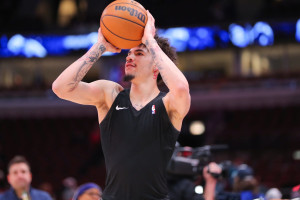
Report: Hornets' LaMelo Ball Won't Be Fined by NBA for LF Tattoo After Cover Request

Updated Win-Loss Predictions After NBA In-Season Tournament
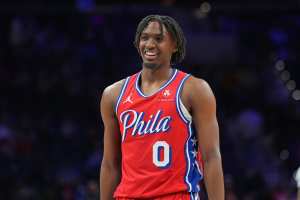
76ers Rumors: Tyrese Maxey to Return vs. Knicks After Clearing Concussion Protocol
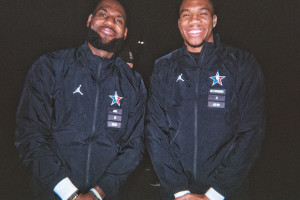
NBA All-Star Game 2024: LeBron James, Giannis Antetokounmpo Lead 2nd Voting Results
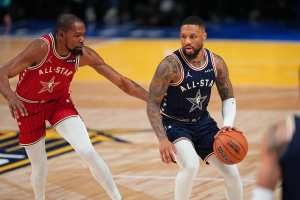
Damian Lillard Wins NBA All-Star Game MVP, Dazzles Fans as East Beats LeBron, West
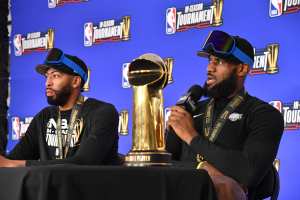
Lakers' LeBron James, Anthony Davis Headline 2023 All-NBA In-Season Tournament Team
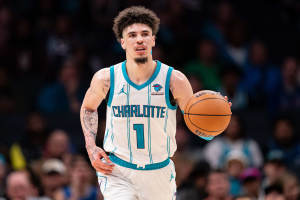
Report: Hornets' LaMelo Ball Likely to Miss Extended Time with Sprained Ankle Injury
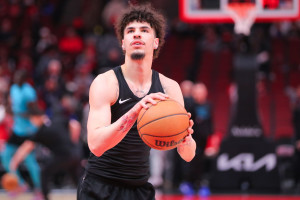
Woj: Hornets' LaMelo Ball Expected to Return from Ankle Injury vs. Spurs





